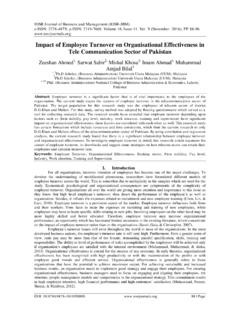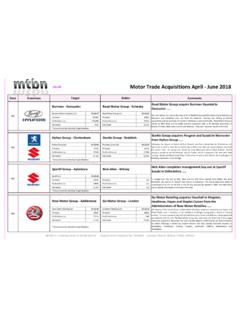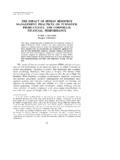Transcription of Labour Turnover & Costs in the Australian Accommodation ...
1 Labour Turnover & Costs in theAustralian Accommodation IndustryPlatinum PartnerResearch ByCHRISTOPHER BROWNM anaging Director & CEO, TTF AustraliaPlatinum PartnerAcknowledgementsProject Reference Panel and Participants:The research for this projectwas undertaken by the GriffithBusiness School at GriffithUniversity, a Sustainable Tourism CRC (STCRC) authors of the detailedproject papers are ProfessorMichael Davidson and Dr NilsTimo. Research assistancewas provided by NatashaCurrant and Scott TTF Australia (TTF) staff who worked on this project were Peter Staveley (NationalManager, Infrastructure,Investment & Planning), HelenEvening (Manager, Research &Analysis) and Kate Lennon (Manager, Hotel Investment).TTF and STCRC thank the following TTF Members for theirassistance during the project:Simone Haynes (Voyages Hotels & Resorts) Paul Mason (Hyatt Regency Adelaide);William Warner (Park HyattCanberra); Peter Wade (Park Hyatt Sydney); DarrylPrince (Accor Asia Pacific); Craig Davidson & Ben McCarron(Hamilton Island Resort) andBruce Copland (Toga Group).
2 2 The tourism industry is a major employer in Australia and has particular significance in regional great benefit of the Accommodation sector of the tourism industry is thatit creates a range of employment opportunities. However, this benefit is alsoa weakness when Labour Costs and availability are under a view to offering an insight into this vital production component for theAccommodation industry, TTF Australia together with the Sustainable TourismCooperative Research Centre, has supported research by the GriffithBusiness School at Griffith University to undertake an examination of a costand activity area of significant sensitivity for the the first time, this research places a cost on Labour Turnover in theAccommodation industry.
3 It shows factors contributing to staff leaving anaccommodation employer, the Costs of recruiting staff, and the cost of training research shows major Costs being attributed to Labour Turnover . Theseare Costs which both the industry and individual operators should examineclosely as they impact substantially on the operating Costs and profitability ofthese businesses. It indicates that the levels of service, experience and valueto consumers may also be the Accommodation industry lose 40% of its managers in one year andstill maintain managerial continuity, efficiency and be profitable? These are allissues that we as an industry need to Australia extends its thanks to the significant number of its MemberHotels who participated in this this study TTF Australia and the Sustainable Tourism CRC hope tohave contributed to the development of the policy agenda of theAccommodation industry.
4 The results provide clear evidence for the need foraccommodation businesses to visit and analyse their own Labour and ByTTF Australia November 2006 BackgroundSince the early 1970 s, tourism has emerged as a significant industry forAustralia. In 2005 the industry contributed of gross domestic product(Department of Industry, Tourism and Resources, 2005).Increases in inbound tourism in the 1980 s and 1990 s resulted in a buildingboom in hotels, resorts, and related infrastructure such as golf courses andretail facilities, and this sector became significant employers of tourism industry is Australia's largest service export industry and contributes significantly to the national economy. Tourism generates $75 billion in consumption and accounts for $ billion of total Gross DomesticProduct (ATSA 2004-05).
5 The national tourism industry directly employsmore than 550,000 people in Australia (1 in 17 jobs or of the workforce). Tourism employment has increased by between 1997-98and light of the important relationship between Labour retention, skills development, quality of service and broader hotel profit strategies, TTFA ustralia and the Sustainable Tourism Cooperative Research Centre(STCRC) commissioned this research into Labour retention and Turnover inthe Australian hotel industry. The research sought to investigate the followingissues as they shape hotel human resource management practice and themanagement of Labour retention, namely: Hotel demographic issues; Assessing the extent of Labour Turnover ; Identifying the push and pull factors impacting on hotel Turnover ; Examining the structure and regulation of Turnover within hotels; Assessing the actual dollar cost of Turnover ; Examining the accountability structures associated with Turnover ; and Exploring best management practice in relation to managing findings in the report are drawn from TTF Members operating residentialhotels.
6 The respondents were Human Resource (HR) the purposes of this research, the definition of Accommodation is derivedfrom the ABS (2006) methodology; thatencompasses 4 to 5 star accommodationand that provides Accommodation as acore on-line survey was prepared based ona concept proposal from Griffith Universityand the Project Reference Panel. It wastested by an industry-based referencegroup of senior hotel industry humanresource managers from both corporatehead offices and individual survey comprised 5 sections requiringresponses on: Hotel background; Hotel employee demographics; Hotel seasonality and turnovercharacteristics; Hotel Turnover Costs byestablishment; and Recruitment and survey was distributed online directlyto TTF Members or through corporatehead offices of hotel companies that areMembers of TTF.
7 Responses werereceived from 64 survey responses were received overa three-month period in late hotel responses represent a satisfactory distribution spread throughoutAustralia. Specifically replies werereceived from the following states and territory:NSW 15NT7 QLD19SA2 VIC11WA4 Unidentified6A statistical software package (SPSS) wasused to analyse the results using standardstatistical analysis based on percentages,means and structuring the data accordingto identifiable groups. After initial enteringof data it was checked for consistency andaccuracy. The results underwent scrutinyby the researchers and TTF to ensureclarity for reporting Turnover & Costs in the AustralianAccommodation Industry3 Key FindingsRespondentsThis research sought information on the characteristics and Costs oflabour Turnover in a selected sampleof large Australian hotels.
8 The sample comprised a major proportion of hotels that describedthemselves as hotels ( %), describing themselves asResort/Hotel and only a very smallpercentage described as motels. Themajority of respondents were drawnfrom the larger 4 5 star hotelswith less than one third of repliesfrom 3 and star properties. 4 and5 star establishments are more likely to have a dedicated HumanResource department that employHR professionals. Because of this,the sample was skewed toward thelarger full 4 5 star service properties. The majority of the hotels (refergraph on page 5) were located in ornear the inner city/central businessdistrict areas and regional towns. The location of the majority of establishments near or in inner city/ CBD reflects the maturation ofAustralia s residential accommoda-tion hotel industry.
9 Operational activi-ties are now more likely to includebusiness and conferences, overnightbusiness stays, visiting family andfriends, as well as the more traditional tourist/leisure four to five star residential Accommodation and hotel industry is a significant employer of Labour . It operates in highly volatile markets. A significant factor in determining how well the industry is performing can begauged by the effectiveness of the industry in attracting and retaining highvalue employees. The data reveals that for operational employees, the overall annual turnoverrate was , which was higher than expected. The data suggests a predictable pattern of high Turnover in the Restaurant/Bar, Housekeeping,Kitchen and Front Office which also represent the largest unit of employment within a hotel.
10 Turnover amongst executives, supervisors anddepartmental managers at was also far higher than levels of Turnover suggest that both managerial and operationalemployees may have similar working experiences in the hotel sector and/orsimilar reasons for causing the high Turnover figures. For example, personnelat all employment levels may be searching for better career opportunities,better pay or better internal transfer Turnover is greatest in regional and remote hotels across all employ-ment categories as compared to inner city/CBD and suburbs. Regionallabour markets are clearly more vulnerable to distance and isolation. Thismakes attracting and retaining employees more difficult. Remoteness, adesire to move on, limited social life, close group living, isolation, etc makeattracting staff to these hotels much more difficult.






